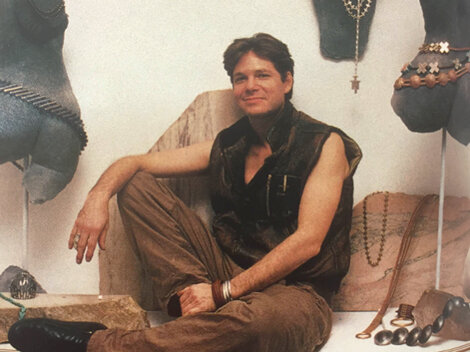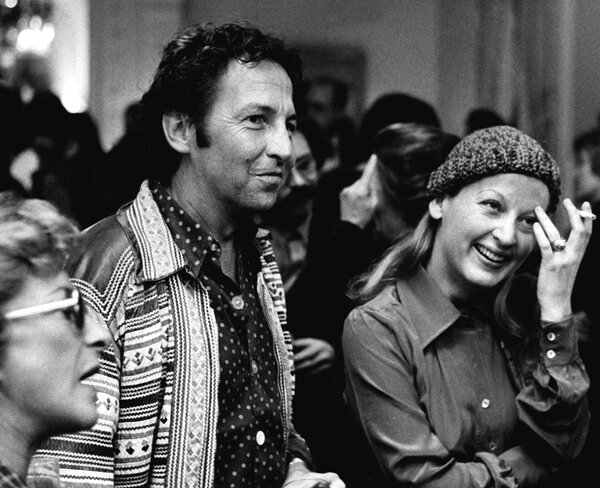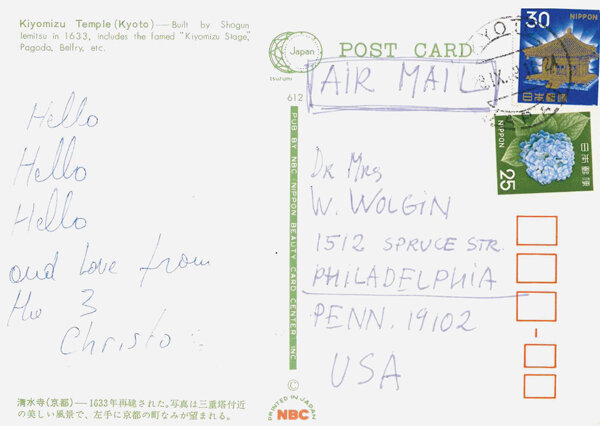209
209
Gold-plated brass
Signed Robert Lee Morris
0.75 in
estimate: $1,000–1,500
result: $252
follow artist



Robert Lee Morris’ jewelry designs effortlessly meld sensual, natural materials with bold and elegant forms. Influenced by cultures from around the world, Morris creates monumental pieces to complement the human form that appear to be simultaneously primitive and futuristic. His works echo the sublime beauty of nature and his use of organic materials imbues his designs with splendor and mystery.
Morris began his formal training studying art and archaeology at Beloit College. After graduating, Morris founded a commune, which was loosely modeled on William Morris’ Arts and Crafts community. Morris created jewelry, teaching himself how to metalwork using hardware store materials. The commune burnt down in the 1970s, but Morris continued to hone his craft.
His works caught the eye of a respected gallery owner who displayed Morris’ work at the Sculpture to Wear gallery in the lobby of the Plaza Hotel alongside jewelry by Man Ray and Alexander Calder. In 1976 his gladiatorial bubble necklace was featured prominently on the cover of Vogue, launching Morris’ career to new heights. The following year Morris opened his SoHo store Artware, collaborating with top fashion designers including Karl Lagerfeld, Geoffrey Beene, and Kansai Yamamoto and Cher, Oprah and Bianca Jagger were among his acclaimed clients.
Morris' bold designs have been featured prominently in the fashion shows of Donna Karan, Calvin Klein and Michael Kors. Morris was honored in a retrospective exhibition, Metalmania: Robert Lee Morris, at the Fashion Institute of Technology in 1996. In 2007, he was awarded the Geoffrey Beene Lifetime Achievement Award from the Council of Fashion Designers of America (CFDA), securing his place as one of the most innovative and inventive jewelry designers of the late 20th century.


I've always wanted my work to be more available...I wanted to offer a range of crazy, experimental, one-of-a-kind pieces that would have integrity and be made of great construction as well as interesting engineering.
Robert Lee Morris

As consummate patrons of the arts, Acey and Bill Wolgin did not just live with the art that they collected—they lived alongside the artists who made it. Through their generous support of both individual artists as well as institutions they cherished, the Wolgins became widely celebrated collectors known for their friendships with artists—including Andy Warhol, Jasper Johns, Claes Oldenburg, Roy Lichtenstein, Arman, and Robert Rauschenberg—that were sustained, not least, by legendary parties thrown at their Philadelphia apartment.
Bill Wolgin, who practiced as a urologist, met Acey through her brother with whom he attended medical school. The pair married and made strong roots in Philadelphia—indeed, the Wolgins may be credited for having a significant role in elevating the City of Brotherly Love to the cultural destination that it is today. In the 1960s, Acey was a founding member of the Arts Council at the Young Women’s Hebrew Association, which helped spark the city’s contemporary art scene. In 1974, Acey became one of the first women elected to the board of the Philadelphia Art Museum, where she served as a trustee and trustee emeritus for the rest of her life. When Robert Indiana’s LOVE stamp was released at that museum, Acey’s birthday party doubled as the event after-party. Among the attendees was the artist Arman, who absconded with a piece of the LOVE stamp-themed cake in order to seal it in resin.

The Wolgins would later relocate to Boca Raton, where they became actively involved in the Boca Raton Museum of Art and eventually funded the Wolgin Education Center. After returning to Philadelphia, Bill Wolgin would become involved in the Woodmere Art Museum as a trustee, helping to guide the institution’s expansion. Works from the Wolgin Collection are now held in all three of the institutions where they became involved, including Yves Klein’s Portrait Relief I: Arman at the Philadelphia Museum of Art, Fletcher Benton’s Donut with Balls and Half Moon at the Boca Raton Museum of Art, and a group of large-scale sculptures by Sam Maitin at the Woodmere Art Museum.

Surrounded by his parents’ collection from a young age, Richard Wolgin recalls meeting many of the artists whose works he knew intimately—especially memorable was the flaming red hair of Jeanne-Claude when she and Christo dropped in one weekend. (When they weren’t celebrating together, the Wolgins kept correspondences with many of their artist-friends, who sent postcards and, sometimes, drawings.) As kids, Richard and his sister would, naturally, delight in playing with one of Harry Bertoia’s sound sculptures. When Richard was twelve years old, Acey gave him his first work: Roy Lichtenstein’s CRAK!, which he affixed to his bedroom wall with thumb tacks—inadvertently bringing the work back into the realm of mass media and pop cultural detritus that so inspired Lichtenstein.
The works featured in The Acey and Bill Wolgin Collection represent a life lived through, and for, art—“It’s not just buying something to hang on the wall,” says Richard, “it’s a piece of their lives, that are now part of our lives.”
Auction Results Robert Lee Morris